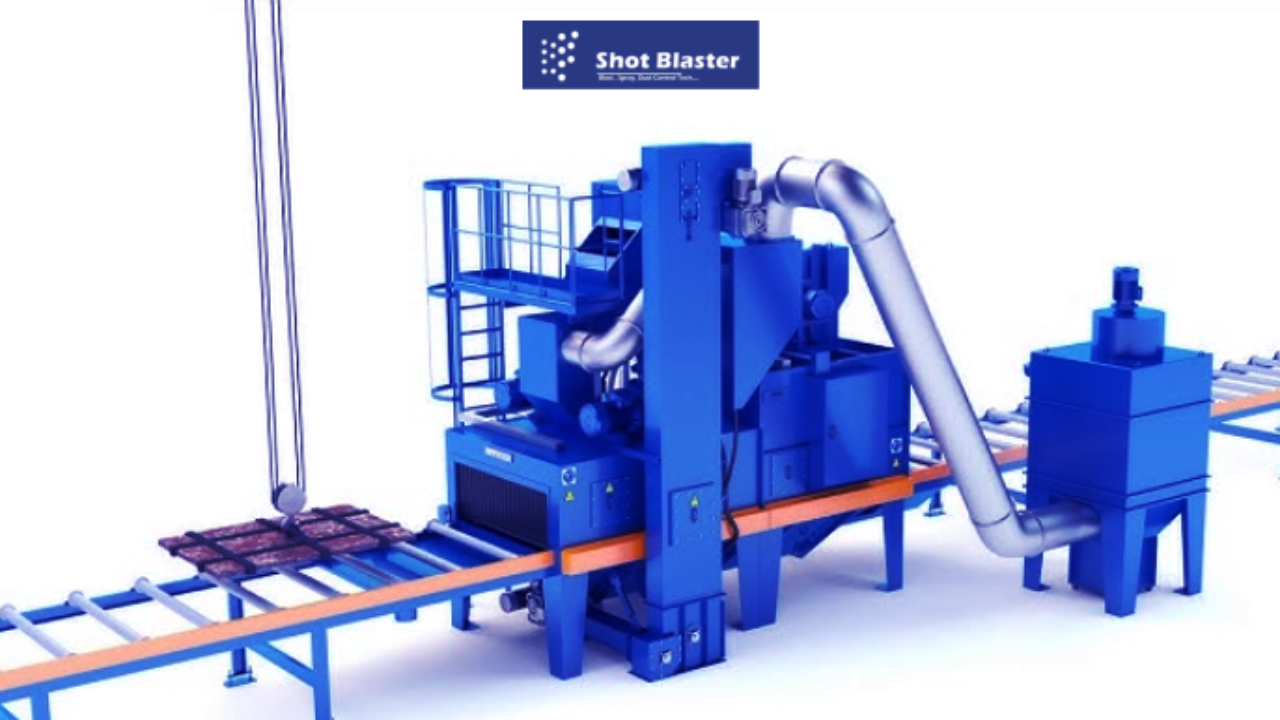Choosing the right shot blasting machine can be tricky. Learn the key factors that will help you select the ideal shot blaster for your needs and ensure efficiency and quality in surface preparation.

Introduction
In today’s fast-paced industrial world, shot blasting machines have become essential tools for surface preparation, cleaning, and finishing. Whether you are working on metal parts, concrete surfaces, or other materials, choosing the right shot blaster is crucial for achieving the best results. With various models, sizes, and features available, selecting the perfect machine can be overwhelming. So, how do you go about making the right choice?
In this article, we’ll dive deep into the world of shot blasting machines, providing you with the knowledge you need to choose the best one for your specific needs. We’ll explore the different types of shot blasters, key features to consider, and common mistakes to avoid. By the end of this guide, you’ll be equipped with everything you need to make an informed decision. Let’s get started!
What is a Shot Blasting Machine?
Before we jump into the details of how to choose the right shot blasting machine for your needs, let’s quickly cover what a shot blaster does.
A shot blasting machine is a mechanical device that uses high-speed steel shots or other abrasives to clean, polish, or prepare the surfaces of materials. It works by propelling small particles, typically through a blast wheel, onto the surface to remove contaminants, rust, old paint, or other unwanted residues. This process improves the texture of the material, increases adhesion for coatings, and enhances the overall appearance of the surface.
Shot blasting is widely used in industries like manufacturing, automotive, aerospace, construction, and metalworking. With various designs tailored to different applications, shot blasters come in many shapes and sizes.
Types of Shot Blasting Machines
The first step in choosing the right shot blasting machine is understanding the different types available. Each type serves a distinct purpose, and selecting the right one is crucial for meeting your specific requirements.
1. Tumble Blasters
Tumble blasters are ideal for smaller parts that need cleaning or finishing. These machines use a rotating drum or barrel to tumble the parts while the abrasive shots are blasted onto the surface. The continuous motion of the barrel ensures uniform blasting. Tumble blasters are perfect for industries dealing with small, bulk parts like fasteners, bolts, or small automotive components.
Key Features:
- Compact design
- Efficient for bulk part cleaning
- Suitable for small to medium-sized components
2. Hopper Blasters
Hopper blasters are typically used for larger parts and more intense blasting. These machines feature a large hopper that holds the abrasive material, which is then propelled onto the surface. The blast area is typically more spacious, making them ideal for larger objects such as car body parts, structural components, and large metal or concrete pieces.
Key Features:
- Larger blast area
- Suitable for heavy-duty blasting
- Adjustable blast pressure
3. Rotary Blasters
Rotary blasters use a rotating wheel to propel the abrasive material at high speeds. This type of machine is known for its efficiency and high throughput. The rotating action allows for more consistent results and is often used for parts with more complex geometries. Rotary blasters are frequently found in industries where high-quality surface finishes are essential.
Key Features:
- High precision
- Suitable for complex parts
- Faster processing time
Read more – https://livepositively.com/what-are-the-different-types-of-shot-blasting-machines/
4. Roller Conveyor Blasters
Roller conveyor blasters are designed for continuous blasting, making them an excellent choice for larger manufacturing processes. They are equipped with conveyor systems that move parts through the blasting area, where they are cleaned or prepared by the shot blasting process. These systems are often used in automated manufacturing lines, providing consistent and efficient results.
Key Features:
- Ideal for mass production
- Continuous operation
- Suitable for larger parts
5. Pressure Blasters
Pressure blasters are more versatile and allow for precise control over the abrasive flow. These machines use compressed air to propel the abrasive material at high velocity. Pressure blasters are typically used for small-scale applications, delicate surfaces, and cleaning intricate parts without causing damage.
Key Features:
- Versatile and adjustable
- Ideal for delicate surfaces
- Smaller scale applications
Key Factors to Consider When Choosing a Shot Blasting Machine
Now that you have an overview of the different types of shot blasters available, let’s dive into the factors you should consider when choosing the right shot blasting machine for your needs.
1. Part Size and Shape
The size and shape of the parts you need to treat are some of the most important factors in selecting the right shot blasting machine. For example, large, flat parts such as steel plates may require a different machine compared to small, intricate components like engine parts or metal fasteners.
Key Questions to Ask:
- What is the average size of the parts you are working with?
- Are the parts uniform, or do they have complex geometries?
- Will you need to treat parts of various sizes?
If you work with larger parts, consider a roller conveyor or rotary blaster. If you handle smaller components, a tumble blaster or pressure blaster might be more appropriate.
2. Abrasive Material
Different abrasive materials are used for shot blasting, each offering unique characteristics. Common materials include steel shots, glass beads, aluminum oxide, and plastic pellets. The abrasive you choose will depend on the desired finish and the material you’re working with.
Types of Abrasives:
- Steel shots: Ideal for cleaning and removing rust from metal surfaces.
- Glass beads: Used for polishing and finishing delicate parts.
- Aluminum oxide: Great for removing tough coatings and cleaning harder surfaces.
- Plastic pellets: Suitable for softer materials or delicate surfaces.
Understanding which abrasive material is best suited for your application will help narrow down the type of shot blasting machine you need.
3. Blast Pressure and Speed
The blast pressure and speed determine the effectiveness of the shot blasting process. High-pressure systems are necessary for tough jobs, like rust removal or paint stripping, whereas lower pressure may be enough for surface cleaning or light polishing.
Considerations:
- Higher pressure machines are more powerful but may wear out abrasive materials faster.
- Machines with adjustable blast pressure allow you to fine-tune the process for different jobs.
Check this – https://livepositively.com/what-are-the-different-types-of-shot-blasting-machines/
4. Production Volume and Efficiency
Another important consideration is how often you plan to use the machine and how many parts you’ll need to process. If you’re running a high-volume operation, you’ll want a machine that can keep up with your production demands without sacrificing quality.
Questions to Consider:
- Are you dealing with large quantities of parts that require continuous operation?
- Do you need a machine that can work in an automated production line?
- How much downtime can you afford for maintenance or adjustments?
For larger operations, roller conveyor or rotary blasters may be the best fit due to their higher throughput and continuous operation. For smaller or occasional jobs, a tumble or pressure blaster may be more than sufficient.
Common Mistakes to Avoid
When choosing a shot blasting machine, it’s easy to overlook some important details. Here are a few common mistakes to avoid:
- Underestimating the Importance of Abrasive Selection: Choosing the wrong abrasive material can significantly affect the quality of the blast and the longevity of your machine.
- Not Considering Maintenance Needs: Some shot blasting machines require more maintenance than others. Be sure to choose a machine that aligns with your maintenance capabilities.
- Ignoring the Impact of Blast Pressure: Higher blast pressure may seem tempting, but if it’s too much for your parts, it could lead to damage. Be sure to select a machine with adjustable settings to avoid this.
FAQs: Answering Your Burning Questions
Q1: Can I use any shot blasting machine for any material?
While many shot blasting machines can handle a wide variety of materials, it’s crucial to choose the right abrasive material for the specific surface you’re working with. For example, glass beads are excellent for delicate materials, while steel shots are better for tougher metals.
Q2: How often do I need to replace the abrasives?
The frequency of abrasive replacement depends on the machine type, the abrasive used, and the nature of the job. For high-volume operations, you may need to replace abrasives more often, but for smaller jobs, they can last longer.
Q3: Is automation necessary for my operation?
Automation is ideal for high-volume or continuous operations. However, for smaller, less frequent tasks, a manual or semi-automatic shot blaster may suffice.
Conclusion:
In conclusion, selecting the right shot blasting machine for your needs involves considering a range of factors, from the type of parts you are working with to the abrasives and machine features that will suit your operation. Whether you’re looking for a high-efficiency rotary blaster or a compact tumble blaster, there’s a shot blasting machine out there for every job.
By carefully evaluating your requirements and considering the factors discussed in this article, you’ll be well on your way to making an informed decision. Don’t forget to factor in the long-term maintenance, ease of use, and production capacity when making your choice!
Take your time, do the research, and choose the right shot blasting machine to meet your needs. Your parts—and your bottom line—will thank you. Happy blasting!
Related Article – https://riyasingh12384.systeme.io/shot-blaster/the-ultimate-guide-to-choosing-the-right-shot-blasting-machine-for-your-project


